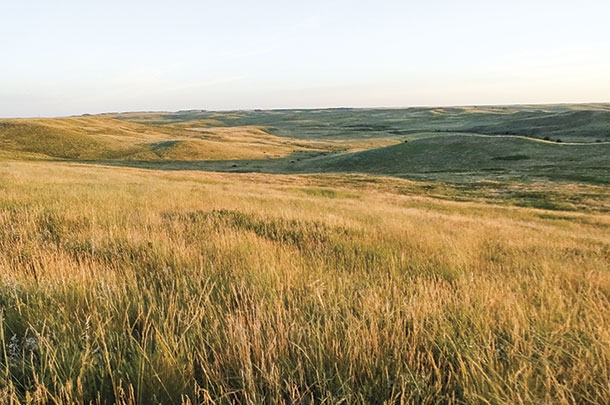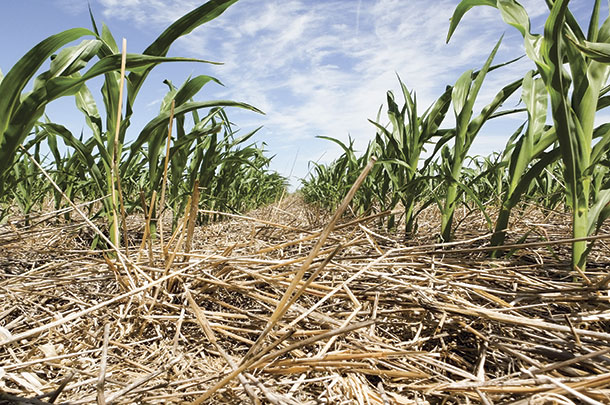Located in Gettysburg, South Dakota, Cronin Farms consists of 7,500 acres of farmland, used mostly for cash crops, and 10,000 acres of grazing land. They also run 800 head of cattle. Brothers Monty and Mike Cronin, along with longtime employee Dan Forgey, make up the management side, with Monty and Mike’s sons completing the workforce.
Mike and Dan are in charge of the farming side of the operation; Monty and his sons run the cattle side with Monty acting as general manager. The farm was established in 1910 by Monty’s grandfather, who moved his family from Nebraska.
In past years, Cronin Farms operated like most traditional farms, but their adoption of no-till in 1992 started the more lengthy transition to more conservation-centered land management practices.
“We started no-till in ’92 with our farming operation, and after watching the results of everything from the conservation-type things, we started applying it more to our grazing side and making the pastures smaller and rotating around,” Monty Cronin says. “In the last eight years, we’ve introduced a lot of cover crops into our farming side of it that we’ll also graze in the fall and in the winter.”
During the spring and summer months, the Cronins depend on their native grass pastureland for feed. “Most of our grazing lands are along the Missouri River, so there’s not really a chance that it will ever be farmed,” Cronin says. “It puts out a lot of grass, and basically all we can do with it is graze it.”

Even their management of native grass pastureland has changed over time. “We try to do it differently, graze at different times of the year and try to keep our native grasses,” Cronin says.
Cover crops have been a great resource for the Cronins. They use them to cover fall and winter grazing. They’ve never used cover crops to offset summer slump or as part of a regular grazing rotation in the summer.
“We’re using our farmground for cash crops at that time of year, then after we harvest we plant a lot of cover crops, and they’re not ready ’til fall,” Cronin says.
Cover crops also help cut down on the amount of hay they use and the time that would normally be spent feeding cattle. “Hopefully, this year we won’t have to feed a bale until sometime in February, and normally in years past we’d start feeding the first of December until they were calved out in April,” Cronin says.
Using cover crops as a main source of fall/winter feed is paying off well for the Cronins. “There’s 160 acres of season-long cover crop that we planted in mid-July, and the NRCS has done a study on it and determined that we can run 650 cows there for about 34 days if we move the fence about every week,” Cronin says. “That cuts down on the winter feed bill and handling tractors and things like that.”
Planning for optimum timing isn’t the only thing the Cronins take into consideration when they are planting cover crops. They plant an assortment of cover crops that includes corn, sudangrasses, flax, turnips, oats, canola and cowpeas, among other varieties.
“It depends on a lot of different things,” Cronin says. “It’s a lot more complex than just going and throwing everything in the drill that you can find. You’ve got to remember what crop you had on it, what crop you’re going to next year, and then you’ve got to figure out disease pressures and things. If we’re rotating to a broadleaf next year, you don’t want to have too much for broadleaf this fall. Vice versa if you’re going to a grass – things like that.”
The Cronins have seen great results from changing their land management practices. “With the no-till with the cover on the ground, by not tilling, we never have water runoff when we get a big rain; everything goes into the ground. That’s the big thing.” It’s the same way with the pastures, he says. “By not grazing too much, you’re leaving more stuff on the ground so the water doesn’t run as bad.”
Water erosion used to be a fact of life in past years at Cronin Farms. “When I was a kid growing up, we had a lot of big washouts in our pastures,” Cronin says. “They’re all grassed over now. It’s just things you see happening because of what you’re doing.”
The Cronins have also tweaked their cattle management program to accommodate their change in land management. “We do a lot of A.I., and we select for real maternal-type cows. Maternal is big in our deal – but performance also,” Cronin says. “And we don’t raise giant cattle; our cows probably average 1,350 pounds. They’re not huge, but they can go make their own living; we don’t have to baby them.”
Cronin says the changes that have taken place over the years have been gradual. He advises being patient when waiting for results. “It’s not instant, it certainly wasn’t for us, and back in ’92 there weren’t a lot of people doing it.
We were guinea pigs, and it wasn’t all success; we had a lot to learn,” he says. “You’ll see results within the first couple of years. Six to 10 years is when you really start seeing results and then, by incorporating the cover crop and keeping the soil active, you can get closer to a year of use out of the soil, all the while improving its quality and nutrient density, versus only a spring or a summer season.”
Cronin says the land has responded wonderfully to the changes they’ve made over the past 25 years. “It’s improved our soil health, our organic matter rates have increased way faster than they ever thought it could be done.” Every element of their management contributes to land improvement.

“Using the no-till and cover crops, it all goes hand in hand,” Cronin says. “Every year we’re learning something new. To think you know it all in this game is crazy – because you never will.”
Cronin says it’s a gradual process to ease into the daily work, and that patience and persistence are paramount. “It’s a daily ‘get your feet wet and try it’ kind of thing. We’ve never done anything where we made a change to the whole place in one year; you just need to try things for a couple years and see how it’s working and then go forward from there.”
Cronin says seeking advice from others who are trying the same thing can help immensely. “There are people all over that are doing this; it isn’t just something that we’ve figured out and are doing on our own. We’ve learned a lot of things from a lot of other people too. It’s an information sharing thing.”
He says word of mouth and help from agencies like the NRCS aren’t the only resources available. “You can learn tons on the internet, then you don’t have to make the same stupid mistakes we made years ago,” he says. “There’s a lot of different ways to get help doing this.”
The Sand County Foundation, in cooperation with the South Dakota Cattlemen’s Association and the South Dakota Grassland Coalition, chose Cronin Farms to receive the 2016 Leopold Conservation Award.
Cronin says the nomination and award were a complete surprise. “I didn’t even realize it ’til we got a call one day that said that we were the winners of it.” He never expected to earn an award for simply taking care of his land. “It was quite an honor to be recognized for something that you do,” he says. “We weren’t out looking to impress anybody; it’s just what we do.” ![]()
PHOTO 1: Cronin Farms’ dedication to better land management is a multi-generational tradition passing from Monty and Mike, to their sons, to their sons’ sons.
PHOTO 2: The Cronins pasture their cattle on native grasses and use a shorter rotation system instead of a seasonal grazing system.
PHOTO 3: The farm transitioned to no-till in 1992, proving vastly beneficial to the Cronins’ farming operation. Photos by Colette Kessler, NRCS.

-
Carrie Veselka
- Associate Editor
- Progressive Cattleman
- Email Carrie Veselka








